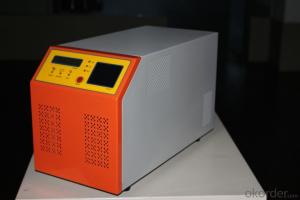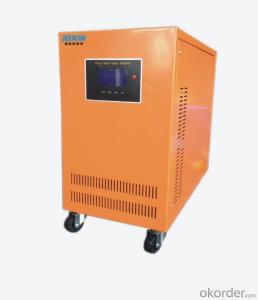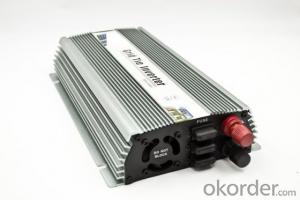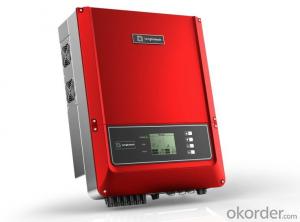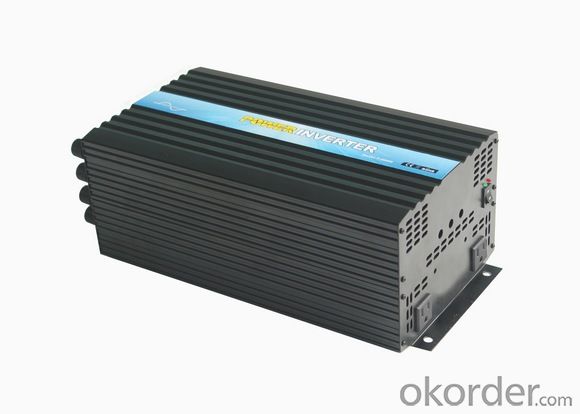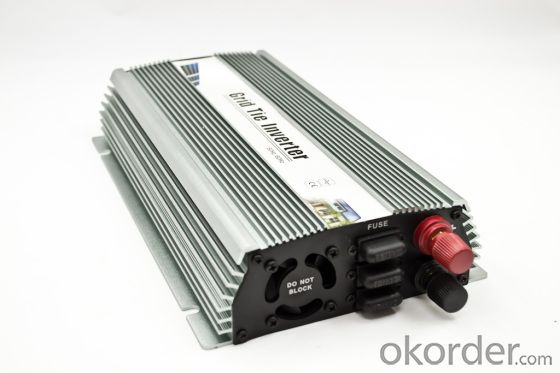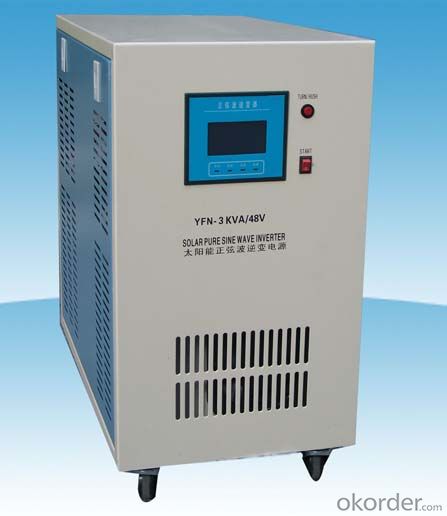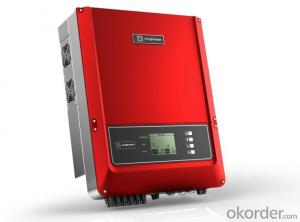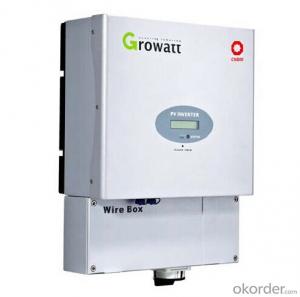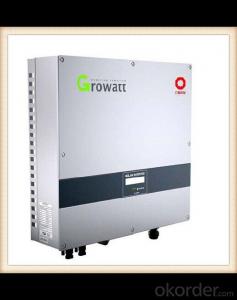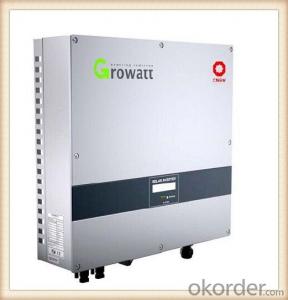Solar Inverter 230v CNBM-H 2KW Hybrid Inverter
- Loading Port:
- Shanghai
- Payment Terms:
- TT OR LC
- Min Order Qty:
- 1000 watt
- Supply Capability:
- 100000000 watt/month
OKorder Service Pledge
OKorder Financial Service
You Might Also Like
1.Description of the Solar Inverter
2KW hybrid inverter
Pure sine wave output
Microprocessor controlled to guarantee stable charging system
Multiple operations: Grid tie , Off grid , and grid tie with backup
Built-in MPPT solar charger
LCD display panel for comprehensive information
Multiple communication
Green substitution for generators
User adhustable charging current up to 25A
2.Data sheet of the Solar Inverter
| Model | CNBM-H 2KW |
| Rated Power | 2000W |
| Grid-tie operation | |
| PV Input(DC) | |
| Maximum DC power | 2250W |
| Nominal DC voltage / Maximum DC voltage | 300 VDC/350 VDC |
| Start voltage /Initial Feeding Voltage | 80 VDC/120 VDC |
| MPP voltage range | 150 VDC ~ 320 VDC |
| Number of MPP Trackers/ Max input current | 1/1 X15A |
| GRID OUTPUT (AC) | |
| Nominal Output Voltage | 101/110/120/127 VAC |
| Output Voltage Range | 88 - 127 VAC |
| Nominal Output Current | 30A |
| Power Factor | >0.99 |
| EFFICIENCY | |
| Maximum Conversion Efficiency (DC/AC) | 95% |
| European Efficiency@ Vnominal | 94% |
| OFF-GRID OPERATION | |
| AC INPUT | |
| AC Startup Voltage /Auto Restart Voltage | 60 - 70 VAC / 85 VAC |
| Acceptable Input Voltage Range | 85 - 130 VAC |
| Maximum AC Input Current | 30A |
| PV INPUT (DC) | |
| Maximum DC Voltage | 350 VAC |
| MPP Voltage Range | 150 VAC~320 VAC |
| Maximum Input Current | 1/1 X15A |
| BATTERY MODE OUTPUT (AC) | |
| Nominal Output Voltage | 101/110/120/127 VAC |
| Output Frequency | 50HZ/60HZ(auto sensing) |
| Output Waveform | Pure sine wave |
| Efficiency (DC to AC) | 90% |
| HYBRID OPERATION | |
| PV INPUT (DC) | |
| Nominal DC voltage / Maximum DC voltage | 300 VDC/ 350 VDC |
| Start voltage /Initial Feeding Voltage | 80 VDC /120VDC |
| MPP voltage range | 150VDC ~320VDC |
| Maximum Input Current | 1/1 X15A |
| GRID OUTPUT (AC) | |
| Nominal Output Voltage | 101/110/120/127 VAC |
| Output Voltage Range | 88 ~127 VAC |
| Nominal Output Current | 18A |
| AC INPUT | |
| AC Startup Voltage /Auto Restart Voltage | 60 - 70 VAC /85 VAC |
| Acceptable Input Voltage Range | 85 - 130 VAC |
| Maximum AC Input Current | 30A |
| BATTERY MODE OUTPUT (AC) | |
| Nominal Output Voltage | 101/110/120/127 VAC |
| Efficiency (DC to AC) | 90% |
| BATTERY & CHARGER | |
| Nominal DC Voltage | 48VDC |
| Maximum Charging Current | 25A |
| GENERAL | |
| PHYSICAL | |
Dimension, D X W X H (mm) | 420x415x170 |
| Net Weight (kgs) | 15.5 |
| INTRRF ACE | |
| Communication Port | RS-232/USB |
| Intelligent Slot | Optional SNMP ,Modbus, and AS400 cards available |
| COMPLIANCE | |
| Standard | CE, VDE, 0216-1-1, VDE-AR-N 4105 |
3.Applications of the Solar Inverter
Inverter not only has direct communication transform function, but also has the maximum limit to carry on the function of the solar cell function and system fault maintenance function. In the aggregate, have active operation and shutdown function, maximum power tracking control function, prevent operation function alone (grid system use), the active voltage adjustment functions (grid system use), dc testing functions (grid system use), dc grounding detection function (grid system use)
4.IMages of the Solar Inverter

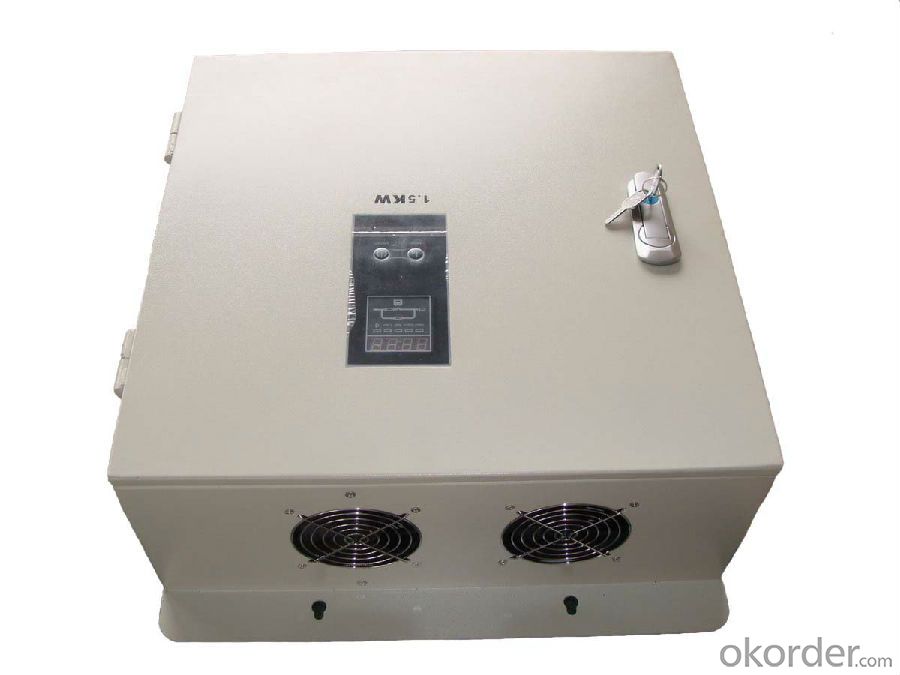
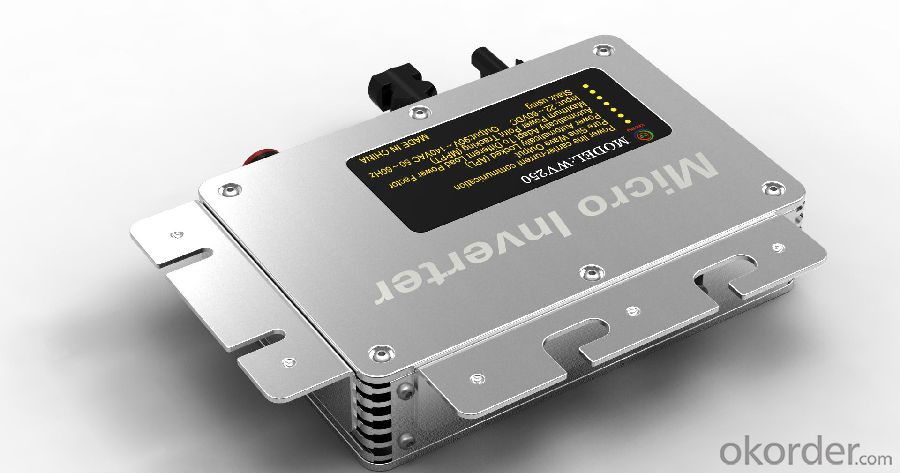
FAQ
Q: Do you have the CE, TUV, UL Certification?
A: We’ve already passed all the tests, and any certificate is available.
Q: Have you ever sold your products to companies in my country?
A: Of course, we have customers in all general PV markets, but I think we should expand our market share along with the market growth.
Q: When did your company set up? You are a new company, how can I believe your quality?
A: We entered into Solar PV industry in 2005, now we have several plants in manufacturing of a-Si and c-Si panels, and our capacity is 220MW per year. Till now we have already passed all the tests by authorized laboratories, e.g. TUV, CE, UL.
Q: Can you help us install the module if we cooperate with you?
A: We haven’t entered into installation sector, but we have the plan in near future.
Q: How do you pack your products?
A: We have rich experience on how to pack the panels to make sure the safety on shipment when it arrives at the destination.
Q: Can you do OEM for us?
A: Yes, we can.
Q: Can we visit your factory?
A: Surely, I will arrange the trip basing on your business schedule.
- Q: Can a solar inverter be upgraded or expanded in the future?
- Yes, a solar inverter can be upgraded or expanded in the future. Inverter technology is constantly evolving, and manufacturers often release firmware updates or offer hardware upgrades to improve performance, add new features, or increase capacity. Additionally, in case of increased energy demands or the addition of more solar panels, it is possible to expand the system's capacity by adding additional inverters or upgrading the existing inverter to a higher capacity model.
- Q: What is the role of a display or user interface in a solar inverter?
- The role of a display or user interface in a solar inverter is to provide real-time information and control capabilities to the user. It allows the user to monitor the performance of the solar inverter, such as the amount of power being generated, the voltage and current levels, and any error or warning messages. The display also enables the user to adjust various settings and parameters of the inverter, such as the operating mode, output voltage, or charging profiles. In essence, the display or user interface acts as a communication tool between the user and the solar inverter, facilitating efficient operation, monitoring, and troubleshooting.
- Q: How does a solar inverter communicate with other devices in a solar power system?
- Various communication protocols and interfaces facilitate the interaction between a solar inverter and other devices in a solar power system. One commonly used method involves wired connections, where communication interfaces like RS485 or Ethernet establish a direct link between the inverter and devices like solar panels, batteries, and monitoring systems. In addition to wired connections, wireless communication methods are also employed. Technologies such as Wi-Fi, Zigbee, or Bluetooth allow the inverter to establish connections with nearby devices. This wireless communication primarily serves monitoring and control functions, granting users remote access to manage their solar power system. Effective communication between the solar inverter and other devices is pivotal for optimal performance and efficiency of the solar power system. Vital data, including voltage, current, and temperature, is transmitted from the solar panels to the inverter. This information is critical for achieving optimal power conversion, as the inverter adjusts its operations based on these readings to maximize power output and ensure system safety. Moreover, communication with devices like batteries enables the solar inverter to efficiently manage charging and discharging cycles, optimizing energy storage and utilization. This ensures that surplus energy generated by the solar panels is effectively stored in the batteries and utilized during periods of low sunlight. In conclusion, the communication capabilities of a solar inverter are essential for integrating and coordinating various components within a solar power system. They enable efficient power conversion, monitoring, and control, ultimately maximizing the performance and advantages of solar energy generation.
- Q: How does shade affect the performance of a solar inverter?
- Shade negatively impacts the performance of a solar inverter as it reduces the amount of sunlight reaching the solar panels, thereby reducing the amount of electricity generated. Inverters are designed to operate optimally under full sunlight, and when shaded, their efficiency decreases, leading to a decrease in overall energy production. Additionally, shade can cause hotspots on panels, potentially damaging the system and reducing its lifespan. To ensure maximum performance, it is important to minimize shade and ensure unobstructed sunlight for solar inverters.
- Q: How do you connect a solar inverter to solar panels?
- To connect a solar inverter to solar panels, the DC output of the solar panels needs to be connected to the DC input of the inverter. This is usually done using appropriately sized and rated solar cables and connectors. The positive terminal of the solar panel is connected to the positive terminal of the inverter, and the negative terminal of the solar panel is connected to the negative terminal of the inverter. Properly following the manufacturer's instructions and guidelines is crucial to ensure a safe and efficient connection.
- Q: Can a solar inverter be used with solar-powered electric vehicle charging stations?
- Yes, a solar inverter can be used with solar-powered electric vehicle charging stations. A solar inverter is responsible for converting the DC power generated by solar panels into AC power that can be used to charge electric vehicles. By using a solar inverter, the solar energy harvested from the panels can be efficiently utilized to charge EVs, making it an environmentally-friendly and sustainable option for charging stations.
- Q: How does a solar inverter handle voltage rise in case of low load conditions?
- A solar inverter handles voltage rise in case of low load conditions by reducing the power output from the solar panels. It does this by adjusting the voltage and frequency of the electricity generated, ensuring that the voltage remains within the acceptable range. This prevents any damage to the inverter or connected devices and ensures the efficient operation of the solar system.
- Q: Can a solar inverter be used in systems with different module currents?
- Yes, a solar inverter can be used in systems with different module currents. Solar inverters are designed to convert the DC power generated by solar panels (modules) into AC power that can be used by electrical devices. They are typically equipped with Maximum Power Point Tracking (MPPT) technology, which allows them to optimize the power output from the solar panels regardless of their current ratings. This means that solar inverters can efficiently handle systems with different module currents and ensure the maximum power generation from the solar panels.
- Q: How do you calculate the maximum power point voltage for a solar inverter?
- To calculate the maximum power point voltage for a solar inverter, you need to determine the voltage at which the solar panels produce the maximum power output. This can be done by following the voltage-current (V-I) curve of the solar panels. By measuring the voltage and current at different points on the curve, you can identify the point where the product of voltage and current is the highest, indicating the maximum power point voltage.
- Q: How does a solar inverter handle voltage dip and interruption?
- A solar inverter handles voltage dip and interruption by continuously monitoring the incoming grid voltage. In case of a voltage dip, it utilizes its internal control mechanisms to stabilize and regulate the output voltage, ensuring a consistent power supply to the connected solar panels. In the event of a complete interruption of grid power, the inverter quickly switches to an off-grid mode, where it utilizes the solar energy stored in batteries (if available) to continue powering the connected loads. This way, it effectively mitigates the impact of voltage fluctuations and interruptions, ensuring uninterrupted power supply from the solar panels.
Send your message to us
Solar Inverter 230v CNBM-H 2KW Hybrid Inverter
- Loading Port:
- Shanghai
- Payment Terms:
- TT OR LC
- Min Order Qty:
- 1000 watt
- Supply Capability:
- 100000000 watt/month
OKorder Service Pledge
OKorder Financial Service
Similar products
Hot products
Hot Searches
Related keywords

